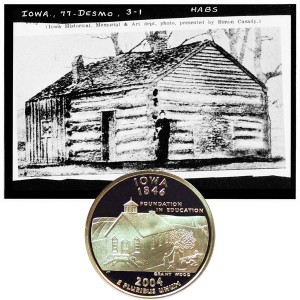Today, the Iowa State Quarter Coin remembers the anniversary of the first incorporation vote for Fort Des Moines on September 22, 1851.
On that day 42 people voted in favor of incorporation with only one negative vote.
In 1853, an Act of the Legislature also incorporated Fort Des Moines.
By 1858, the Legislature moved the capitol to the re-named city of Des Moines.
For those early days, Johnson Brigham captured a description of the frontier in his book Des Moines, The Pioneer of Municipal Progress and Reform of the Middle West published in 1911.
=====
For several years Dr. James Campbell was mentioned as the oldest settler in Des Moines. He came to Fort Des Moines in 1845, at the time the last payment was made the Indians.
He returned to Van Buren county for the winter and in March, 1846, took up his residence in Fort Des Moines.
He was not permitted to settle on the garrison side of the river. He therefore joined a little coterie of settlers on the East side.
Dr. Brooks offered him the hospitality of a blacksmith shop until the West side should be opened.
To a Register reporter a half century afterward, he described the town as it looked to him when he arrived in March, 1846.
He found “only a few log huts beside the barracks. There was one where the Savery House now stands, another on the corner of Walnut and Third streets, and a sutler‘s store down about Third and Vine streets, a little south; just where Third and Vine streets cross was the guard house, a log cabin of two rooms.
“The rifle range was laid out from there to the present site of the Diagonal depot, on ,Fifth street, where the big target was set up.
“The present location of the Morgan House was a big pond.”
Dr. Campbell described the inrush of settlers after the departure of the Indians.
Most of the settlers were “young married men, who brought their families. . . . The country wasn’t surveyed then, or for several years afterward, so we just went out and marked out our claims as best we could guess.
“Each man was entitled to take 160 acres of timber and the same amount of prairie. When a man had marked out his claim, by staking it out or blazing the trees, his title was just as secure as if he had a warranty deed.
“If he complied with the law by eating and sleeping on his claim at least twice a year, no one could take it from him.
“The settlers stood by each other. If any squatter came along and tried to get a man’s claim away from him, the settlers just went to work and moved his things off and if he made any fuss, he got a good thrashing and was glad to get off with that.
“These titles were so permanent that afterward when the land was surveyed, and of course the original lines were changed so that the claims were overlapped, there was a general deeding of one settler to his neighbor for the land that lapped.
“I had a claim of 54 acres, at that time lying northwest of Eighth and Mulberry streets, which was what I had left after deeding the overlapped land to my neighbors, whose claims reached into mine. . . .
“I opened a dry goods and grocery store here shortly after I came. Goods had to be hauled from Keokuk most of the time, where they were brought from St. Louis in boats.
“In the summer the steamboats came up the Des Moines river with goods. I have seen four steamers unloading here at one time. That was in 1851.
“Men used to go down to Keokuk with ox teams and haul big loads up here, for which they got $2 a hundred. . . . It is 202 miles to Keokuk by the Des Moines river, and only about 165 by road.
“People came here from north and west 80 miles and more to buy what few groceries and dry goods they had to have.
“There was no settlement west of here —as late as ’50 there were only three houses between here and Council Bluffs, and nothing between here and Fort Dodge.
“They would come in the fall to get the goods, get trusted till spring and pay in hides, etc.
“Fur of all kinds was very plenty and brought very poor prices, but there was very little money in the country. . .
“It was nothing at all for a man to go out and shoot a few deer, or elk, or bear.
“I had a park here, and we used to go out and capture young elk and put them in the park. At one time we had nineteen in the park. . . .
“They were very easily tamed and I had harnesses made to fit and broke a pair of buck elks to drive to a light wagon. . . .
“The only trouble with them was that they stopped to look around too much.
“Oh, but this was a garden spot then! There never will be another country like it. Timber, water, prairie land, all of the best. and full of game and fish.
“The prairie was covered with the richest growth of blue grass you ever saw— as high as a man’s head. . . .
“Those were the days for young men.”
=====
The Iowa State Quarter Coin shows beside an image of the first house built in Des Moines.
